-
Posts
270 -
Joined
-
Last visited
Content Type
Profiles
Forums
Store
Help Articles
Posts posted by Baron d'Apcher
-
-
Cheerfully withdrawn, though it is unfortunate.
Most females are V notched, even over there and it takes almost 5 years for the notch to disappear.
Lovely work nonetheless.
-
Prawn, I have to agree. I always choose females when I buy the Maine/Canadian lobsters we get here, and it so happened that these four were all both female and pregnant. In my opinion, they are all around a better lobster.
Nice pics, but I don't think it is legal to take, transport sell or possess egg-bearing lobsters in Maine. Or Canada.
http://www.mainelegislature.org/legis/statutes/12/title12sec6436.html
- Landing egg bearing female lobsters is prohibited in all US and Canadian waters. This management measure is one of the very best protections afforded to lobsters. Fishermen have long accepted that protecting the brooding lobsters will help protect the future of the industry.
The fines range from $500 to $10,000.
-
Chicken giblets.
The livers as a terrine with thyme and Port wine. Gizzards confit with pickled ramps & carrots.
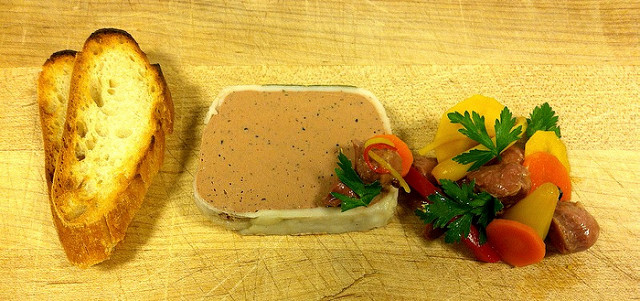
-
 3
3
-
-
^ Consider greasing the mold with butter and cook at a higher temp (425F) for the first 40-60 minutes, rotating half-way through. Then lower the temp.
Rabbit in Riesling, with carrots, mustard and mint.
Rabbits simmered in Riesling with orange and yellow carrots, set with gelatin, loins down the middle, finished with mustard seeds and mint.

Chicken Galantine with confit gizzards, Sicilian pistachios and stuffed morels.
Ventrèche, green peppercorns, tarragon, lemon and star anise.
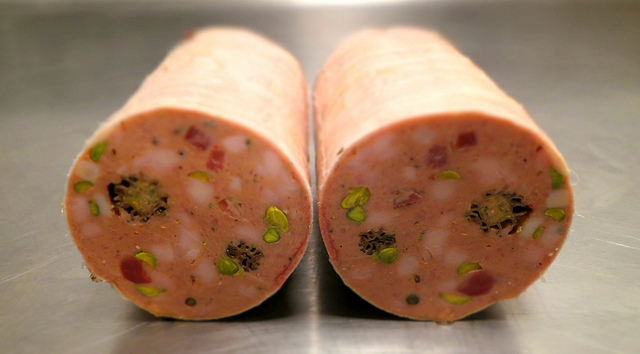
-
 3
3
-
-
Red onion and spring garlic matignon.
With lemon, zest and dried chili.
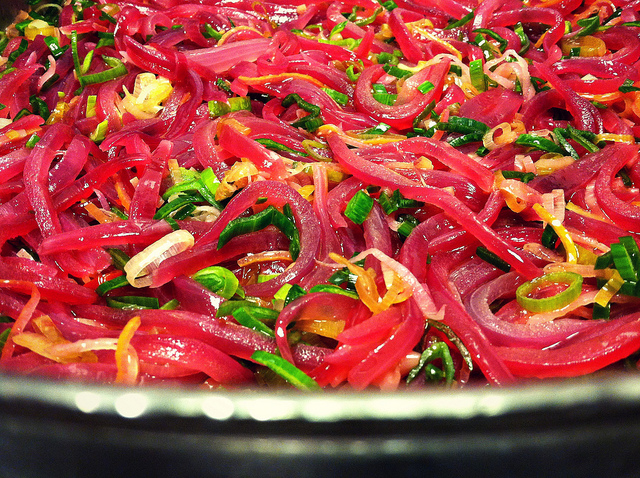
-
King Salmon and King Crab Terrine.
Riesling aspic, a claw and gravad lax.
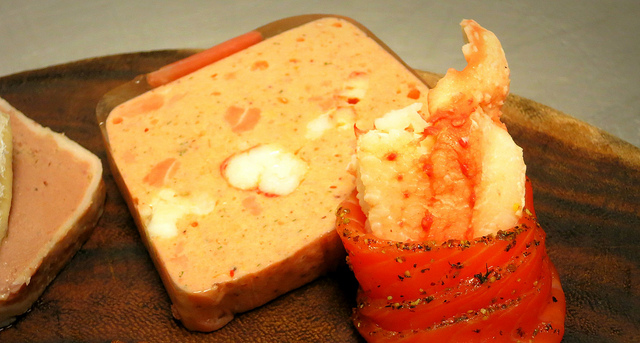
-
 2
2
-
-
Cool Ranch Doritos, McDonald’s French fries and a slew of other processed foods are heavily engineered to taste good, but I hesitate to praise them as a quality product based solely on instant gratification, and I feel that the same considerations and consequences should be taken into account when judging the merits of a noble food item that demands so many resources to raise and bring to the table.
The EU only recently (2009) allowed the importation of more US and Canadian beef in exchange for lower tariffs on EU food items like truffles, roquefort, chocolates and such, but it still forbids the import of any beef that has been treated with growth hormones due to consumer health concerns and must be of the highest quality and still Europe only accounts for 3% of US beef exports. Less than 4% of graded US beef is prime. Most US beef exports go to Canada/Mexico and Japan. Virtually all the beef raised in the US is given synthetic growth hormones and antibiotics. Pastured steers account for barely any of the retail beef that is available to consumers and butcher shops that can meet that low demand are few and very far in between.
Brazilian, Uruguayan and Argentine beef is mostly 100% grass-fed, though the Brazilian rain forest has suffered significant deforestation as a result. European consumption of meat is in decline, while US consumption is expanding, along with health consequences from an increased collective waistband. Over 90% of the beef raised in the US goes to feedlots where they are given synthetic growth hormones and fed corn to fatten them up and get them to market quicker. Almost half the corn grown in the US goes to feeding cattle and the environmental consequences of that variety of industrial agriculture’s runoff down the Mississippi has created a “dead zone” in the gulf of Mexico the size of New Jersey where nothing grows.
An NPR vignette on Profit vs Quality
http://www.npr.org/templates/story/story.php?storyId=113314725
-
so where does all the rest of 'prime' meat go? in this age of economics and marketing, what happens to it?
Not all the cuts within a side are graded, and a majority of whatever is deemed up to snuff is sent to wholesale purveyors and restaurants. Very little goes to supermarkets. Probably because the public is generally used to artificially devalued feedlot beef, beef has become a cheap commodity and few consumers are willing to pay a premium for quality food. My personal feelings on the limited availability of a wide variety of raw ingredients is that most Americans don't cook so there is little demand for butcher shops, specialized produce shops, bakeries, fishmongers and whatnot like in western Europe. Supermarket prize value & convenience.
When grading the carcass, the side is split between the 12th & 13th rib, separating the rib-eye from the shortloin, so that the inspector can grade based on maturity (age of the animal), intramuscular fat, fat cap, color and other standards based on the cut face. Its not like they grade each sub-primal like shanks and bottom round because they have no idea what the muscle looks like without cutting into the round and those cuts aren't premium or highly valuable.
In France the carcass is graded on a EUROP scale for musculature, and then 1-5 for marbling.
E= Excellent - U= Very Good - R= Good - O= Fair - P= Mediocre
I found the quality of beef in France to be infinitely better than the American tastes and standards of quality. The older steers (deemed too old by USDA standards) are able to grow to a larger weight and marble naturally with a grass-only diet, which explains why American 24 month old 100% grass-fed steers are so small and lean. The pistola cuts below are sides cut behind the 5th rib and the breast plate is cut out (it does not age well) and resembles a pistol or sorts. While the 100% grass fed beef often doesn't have the marbling and taste that American palates crave, it has far more anti-oxidants which allow it to stay bright red (corn finished beef will oxidize when cut) and has considerably more nutritional, environmental and ethical benefits. The fat -though not entirely apparent in the picture below- is the color of butter.
Minimum 4 year-old, 100% grass fed Normande breed rib-eye at Hugo Desnoyer.
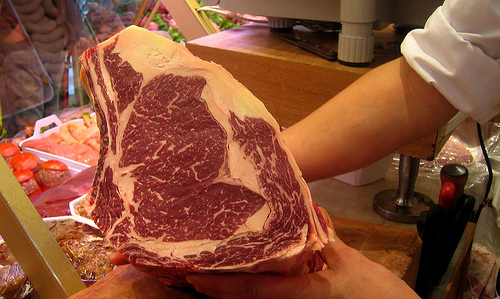
Minimum 4 year-old 100% grass fed Limousin breed pistola cut sides, dry aged 4 weeks.
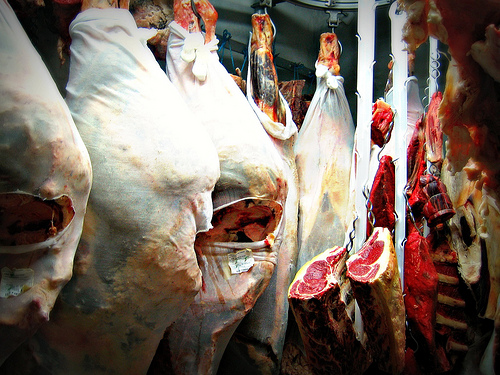
-
Traditionally, "London Broil" is flank steak. Top round being passed as LB is a recent innovation of sorts.
A compromise between the two is to get the top round cap (gracilis) which has similar texture to flank and sirloin butt flap. The gracilis is sold as Santa Fe cut.
-
Encornet Farci.
Squid stuffed with seafood boudin. Asparagus and spring onions.
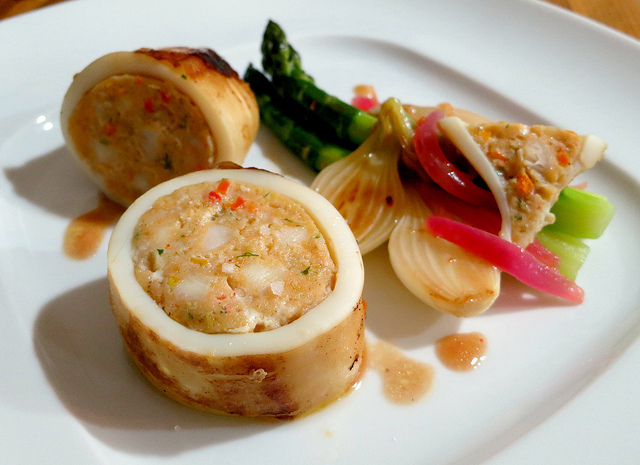
-
For cassoulet purists, there are 3 primary varieties which all fight for the distinction of having invented the dish and each comprising their particular base proteins (only one traditionally features duck):
Castelnoudary, “The Father”; pork products (shank, belly, butt, shoulder, sausage, etc…) and goose or duck confit.
Carcasonne, “The Son”; pork and red-legged partridge.
Toulouse, “The Holy Spirit”; pork, lamb, mutton, duck confit, Toulouse and pork skin sausage (saucisse de couenne -French version of cotechino).
According to Prosper Montagé,a Carcansonne native who drafted the first edition of the Larousse Gastronomique and most rival Chauriens, a legend suggests that the cassoulet started in Castelnoudary during the Hundred Years’ War as a means of feeding the troops who, well fed by an enormous ragoût called estofat later beat the Brits. However, common beans weren’t introduced to Europe from South America until the 16th century, so the story is probably a comforting tale to reclaim some sort of honor after the town was mostly burned to the ground during said war. Dried favas or other broad beans were likely used back then and the dish was called estouffet up until the 18th century when it acquired the cassoulet title. Any authentic version of either from the cassoulet trinity should contain pork skin lining the cassole which thickens the cooking liquid and prevents the beans from burning.Cassoulet is not so much the elements as it is the manner of cooking the beans; using water (eventually some tomato product) and collagen-rich pork skin whose gelatin thickens the bean liquid. Personally, I cook shanks with the beans in the oven (garbanzos cook evenly) then pick the meat and return it to the beans with other flavoring agents based on the season.
Cassoulet printanier. Tarbais beans, mini suprema onions, radishes, spring carrots, pork shank, saucisse de couenne and braised belly.
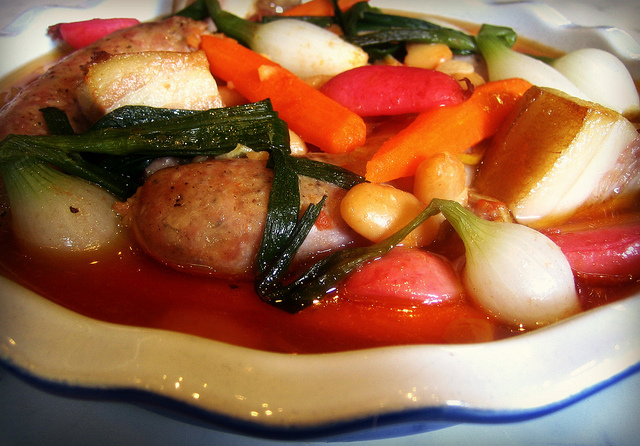
-
The german variety is available online.
It is safe to consume.
http://www.amazon.com/Vinegar-Essenz-Concentrated-percent-fl-oz/dp/B000LRH7TY
-
For Cochon555 DC 2013.
Prosciutto Cotto & Mortadella
Asparagus in blood aspic
and chicories in a smoked ham-hock vinaigrette.
-∞∞∞-
Leverpostej.
Danish-style liver terrine.
Salted and cured anchovies, a couple of marinated capers.
-∞∞∞-
Pâté en Croûte
It’s heart, tongue, fatback, pistachios and a few figs.
Some pickled rhubarb and mushrooms.
-∞∞∞-
Pork Belly Pojarski
Breaded and fried
Sauce gribiche
-∞∞∞-
L’Astet
Loins roasted with spring garlic.
Warm confit potatoes and rillettes
-∞∞∞-
Saucisson en Brioche
Clothbound cheddar sausage baked in a leaf lard brioche.
And cracklin’ whipped lardo.
1st 3 courses.

Pâté en Croûte with pistachio inlay.
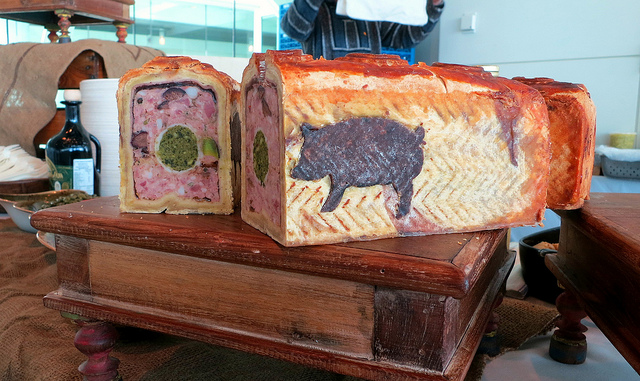
Prosciutto Cotto, Mortadella, Spalla Cotta and Saucisson en Brioche.
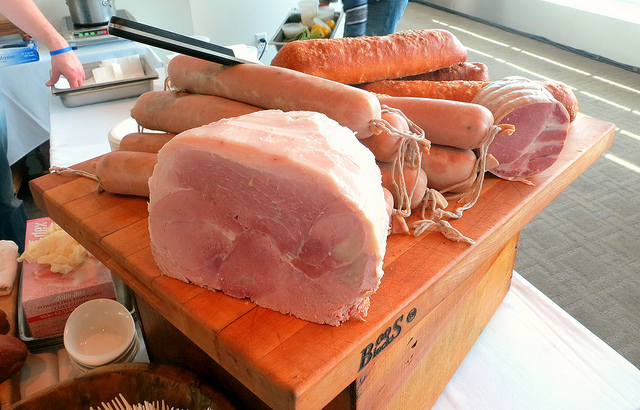
-
 3
3
-
-
Barigoule has been bastardized and diluted over the last few centuries. Not sure why or how the recipe (d)evolved, but originally, artichokes à la barigoule appeared in the 18th century and the name is attributed to the milk cap mushroom (Lactarius deliciosus) known as the “barigoult” derived from the provençal berigoulo. The artichokes are cut as one would pick the mushroom, turned so that they resemble the mushroom in appearance and cooked in olive oil as the mushrooms would be. Later, they were stuffed with a mixture of the mushroom and onion, wrapped in fatback or pork belly (ventrèche or petit sale) and then slowly braised.
"À la barigoule" is cooked in the manner of the mushroom.
-
Artichauts farcis en crepinette.
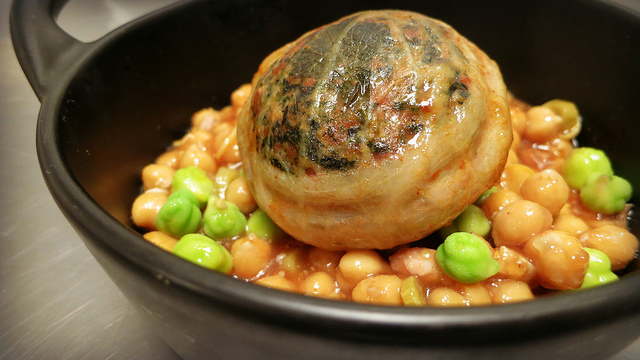
Artichokes stuffed with pork and turnip greens. Bound in caul fat then gently roasted with my ventrèche, lemon and olive oil. A ragout of dried chickpeas simmered with pork shanks, some fresh chickpeas and sliced artichoke stalks. Toasted bread crumbs to follow.
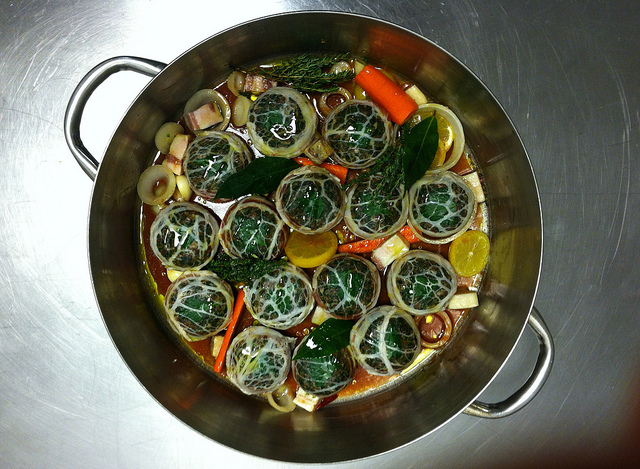
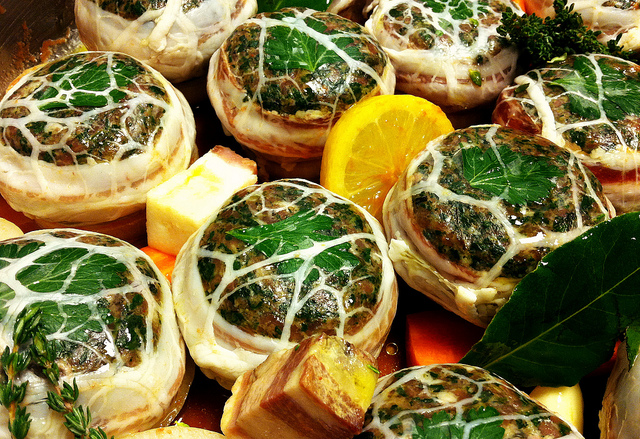

-
 1
1
-
-
Redemption, of sorts. Special "circle fixation" edition.
Squab inlay.
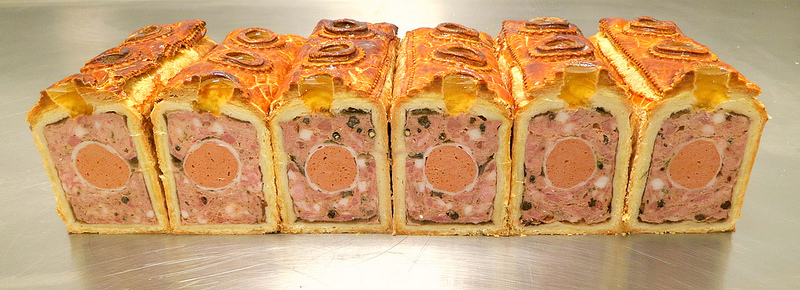
Rabbit, hunter style. Marinated in red wine, stuffed with the loin, lardo and black trumpet mushrooms. Whittled turnips, little red onions, yellow-foot chanterelles. Plated by Bryan Voltaggio.

-
 1
1
-
-
So that I have enough seasoned oil to emulsify into the tuna sauce and to cover whatever portion i have leftover without resorting to using those awful bags, which I believe are the scourge of culinary humanity. The waste generated by restaurants is shameful and while the guy who signs my paycheck insists on using this trend, i'll try to forego using another bag whenever I have the opportunity to. Whoever is able to develop a reusable vacuum bag will retire on a beach next to the folks who developed Cool-Ranch Doritos flavoring.
-
I had consulted the charts but they do not go past 140F and I am trying to replicate "canned" tuna with cuts closer to the tail so that I can purée it, so something cooked to about 150+.
-
Any recommendations for time and water temperature to pasteurize tuna "confit" (internal temp 145F and/or 160F)?
40mm thick pieces, cooked in grapeseed oil (50% by weight of the fish).
I've had good results in 145F water for 1 hour (40mm thick pieces) but want to ensure good shelf life until I can use it all up.
-
Winner of the 2012 World Pâté Croûte Championship: Yohan Lastre, La Tour d'Argent *

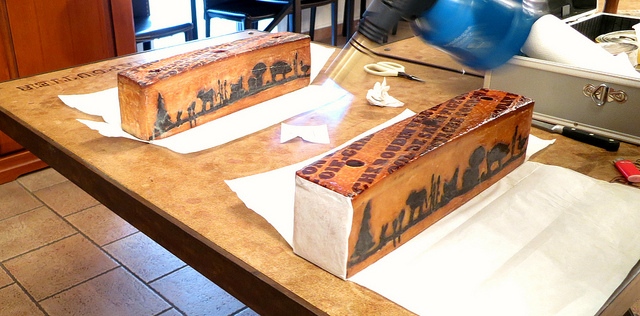
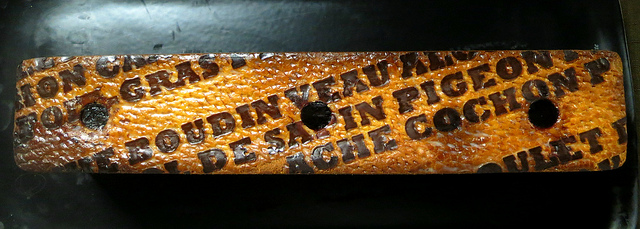
Cyril Malard; Elle Ixir. Lyon
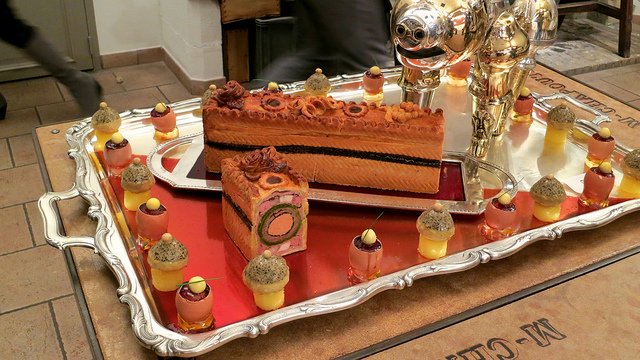
I finished 11 or 12th. Not sure since all remaining 7 competitors after the 4 prizes are grouped together.
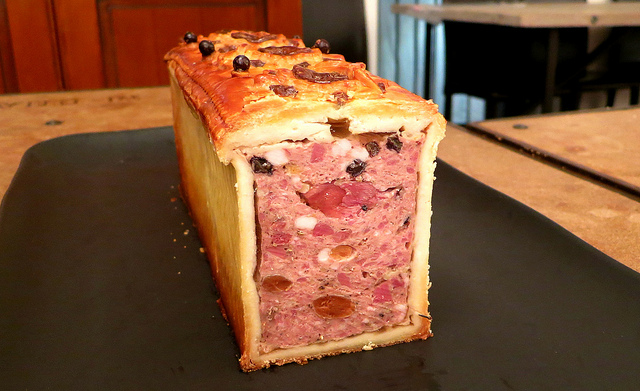
I was exposed to dizzying level of professionalism and experience and feel that I fell short. Having to bring my wares from so far away put me at a considerable disadvantage, perhaps more so without the ooh-la-la garnishes & flair (though presentation accounted for few of the 200 total points) and I picked #12 at random, placing me last in the tasting, at which point the judges may have had their fill. Judges included Regis Marcon (Le Clos de Cimes ***), 2011 winner Eric Desbordes (Le Bristol ***) and numerous MOF’s. My mistakes were significant, but at least my slices stayed together –another contestant’s aspic was too loose and the pastry collapsed when cut. First and foremost, my pastry (80pts) did not achieve enough color, likely a result of baking 3 at once, thereupon lowering the temperature of the oven. Had I cooked it longer at that temp, I would have risked overcooking the forcemeat. I did not have a consistent gap for the aspic either.
Upon speaking with Patrick Henriroux (La Pyramide **, MOF) he said that the judges prefer a chunkier forcemeat, and that I should have kept the gizzards whole. Keeping pace with the gin flavors I finished the slice with fleur de sel mixed with lime zest and ground juniper berries. M. Henriroux explained that juniper is not a flavor that the judges crave. Pickled cauliflower lightly dressed with an orange zest & confit fat soffrito didn’t compare to some of the Bocuse d’Or inspired garnishes put forth by other competitors, but wasn’t worth many points anyway. Lastly, I should have pulled the pâté out of the fridge earlier so that it would have been served at room temperature which otherwise mutes the flavors. Now I know better and being exposed to such work has been invaluable.
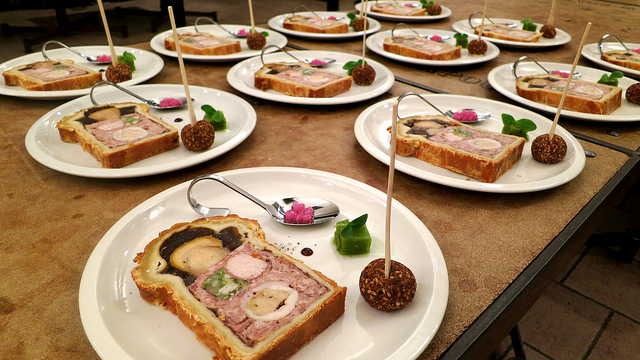
Frédéric Cote; Au Colombier. Lyon
-
 1
1
-
-
The aforeposted pictures and a detailed recipe were assessed by the Pâté Croûte committee and was deemed up to snuff by Le President des Tocques Blanches (Christophe Marguin), securing me a place among the 12 finalists. I am the first (and so far only) American (though I am also a French citizen) to have qualified for the competition (the 4th edition) and will have the undesirable handicap of having traveled the farthest with 3 pâtés and accoutrements stowed at the mercy of baggage handlers on both sides of the Atlantic. I will compete (on behalf of Bryan Voltaggio's Range restaurant in Friendship Heights, Washington DC) against chefs from tiny kitchens and 7 Michelin star rated brigades then be judged by MOF’s and experts in the craft. Thank you to Egullet and its members for allowing me a venue to show my work.
Highlights from the past competitions:
2.0 Special Cocoa Edition:
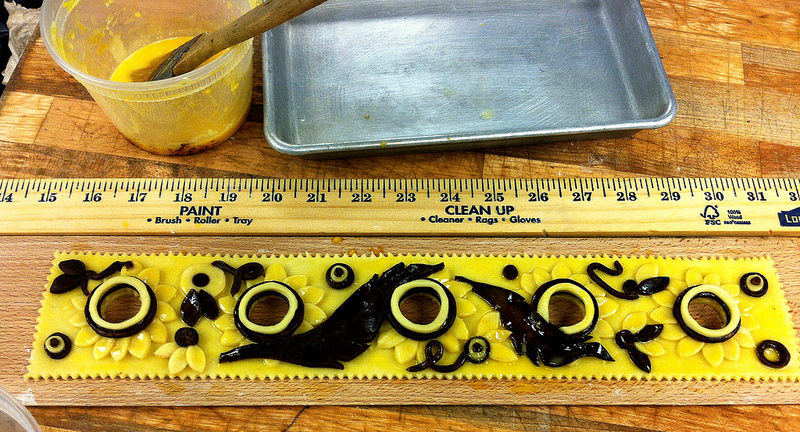
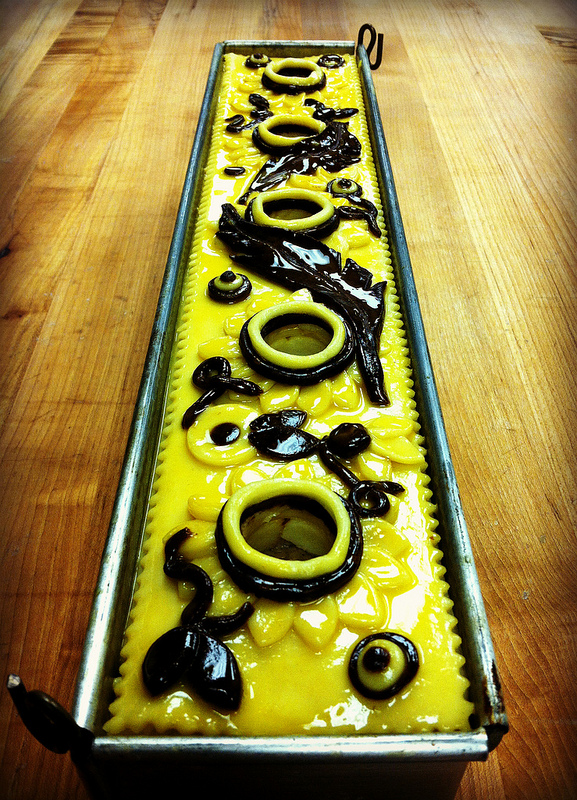

-
 1
1
-
-
On a younger animal (8 month rose veal), the connective tissue hasn't developed as much as on a 2 year old. There is indeed connective tissue (i misspoke) but not like in a flatiron. Generally, I prefer to eliminate all the silver skin and sinew from the round, sear it and slowly simmer it stove-top, submersed in liquid as for vitello tonnato -until internal temp of 135F. Not the choicest of cuts, but with enough discipline it can be palatable.
-
A properly cleaned eye of round has little to no connective tissue (a go-to cut for bresaola and carpaccio) and depending on the breed, size and age of the animal can be quite tender. The muscle is generally lean but not at all sinewy like a shank. Consider cooking it for far less time, as you would for a top-round roast beef, flatiron or strip loin.
-
Pork, Apricot, Pistachio Pâté en Croûte. Special Inadvertent-Argyle-Peppercorn-Nipple Edition
Dot Matrix

One fell off the pâté nest.

Meat Mondrian
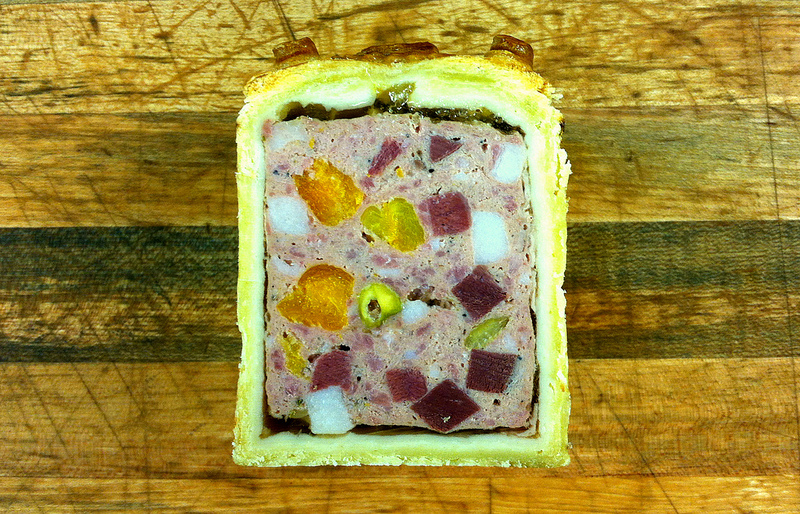
-
 1
1
-



Dinner! 2013 (Part 3)
in Cooking
Posted
Eggs on the inside is completely different than eggs on the outside.